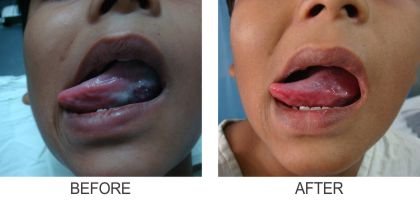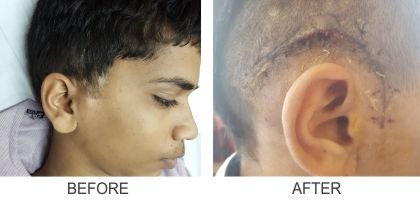Vascular Malformations (Birthmarks) Treatment
Vascular malformations or birthmarks (often misinterpreted as haemangioma) which are deep or extensive are treated by vascular specialist by the following methods:
- Sessions of sclerotherapy
- Angiographic embolisation
- Surgical excision
Dr. Sumit Kapadia is a national expert in this difficult and often inadequately treated vascular problems and his proficiency has helped numerous patients suffering from vascular malformations.
Frequently asked questions

A vascular malformation is an abnormal development of blood vessels including including veins, lymph vessels, capillaries, and arteries. Venous malformations are the most common type of vascular malformation. They are caused by abnormal widening of the veins or a tangle of small veins that does not affect the arteries. Vascular malformations are categorized based on the type(s) of vessels involved and how blood flows through them. Vascular malformations includes following:
- Capillary malformations, also known as port-wine stains
- Slow-flow venous and lymphatic malformations
- Fast-flow arteriovenous malformations (AVMs) and arteriovenous fistulas (AVF)
- Congenital mixed syndromes such as Klippel-Trenaunay Syndrome
Vascular malformations symptoms depend on the type. Vascular malformations that affect your skin may look like a raised red, blue, purple, brown or black birthmark. These marks may swell, bleed or cause pain.
An Arteriovenous Malformation (AVM) in the brain may not cause symptoms unless it bleeds. Arteriovenous Malformation of the brain that bleeds can cause headaches, seizures or muscle weakness, paralysis on one side of your body.
Venous malformations can cause body aches, pain, swelling, problems with blood clotting and organ damage.
Vascular Malformation can often be harmless and minor but occasionally be very serious, sometimes even life threatening. The biggest concern related to AVMs is that they will cause uncontrolled bleeding or hemorrhage, If a hemangioma has uncontrollable bleeding then that could also be life threatening.
Vascular malformations are a result of localized or regional abnormal development of vascular and/or lymphatic channels which develop in utero. They are typically present at birth (congenital). If situated in deeper locations, they may not be easily seen in initial years of life.
Less commonly, an injury in which there is unknown damage to the vessels can over time develop into a vascular malformation. in some people inherit gene changes that cause conditions that increase the risk of vascular malformations.
In a small number of cases, people inherit genetic changes that make vascular malformations.
Hemangiomas are a separate group of Vascular tumors, which rapidly progress in infants and 90% of these show spontaneous regression within 3 to 7 years.
However, vascular malformations do not show any regression and do not go away on their own. They will increase with age. These malformations may show rapid growth at puberty or after pregnancy.
Vascular malformations may become apparent later in life as blood flow increases through abnormal connections between arteries and veins. Most vascular malformations require treatment, to improve appearance and increased pain, swelling, and bleeding. Sometimes we can completely cure a vascular malformation. There is no complete cure for vascular malformation and many patients will need treatment at different times throughout their lives.
Vascular anomalies are very complex, so we take a collaborative approach to diagnosis and treatment, working with specialists. We use magnetic resonance imaging, to pinpoint malformations deep in the body.
The most common techniques available to treat vascular malformation are:
Embolization: which is a minimally invasive procedure that closes the abnormal blood vessels from the inside using “glues” or particles.
Laser treatment can be effective for treating superficial venous malformations or the superficial component of a deep lesion. We also combine laser treatment with surgery and sclerotherapy to successfully treat compound venous malformations.
Sclerotherapy helps us treat venous malformations and lymphatic malformations. We inject a substance through your skin into the malformation. This approach produces a blood clot, which effectively stops the flow of blood in the area. Inflammation of the inner wall then destroys the malformations, which the body replaces with scar tissue called sclerosis.
Vascular malformations are benign in other words non-cancerous lesions that are present at birth, but may not become visible for weeks or months after birth. Unlike hemangiomas, vascular malformations do not have a growth cycle and then regress but instead continue to grow slowly throughout life.
Yes, Vascular Malformations are a type of birthmark or a growth, often present at the time of birth. Congenital vascular malformations (CVMs) are growths or birthmarks made up of blood vessels that have not developed correctly.
Yes, Vascular Malformation can sometimes be caused by inherited or somatic genetic mutations.
Gallery

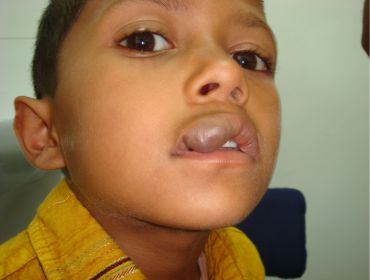
Vascular Malformation Lip
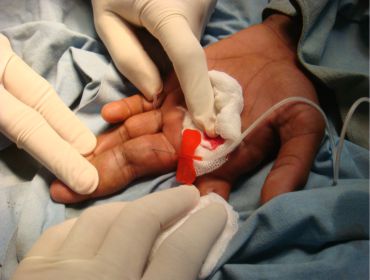
Hand Vascular Malformation-Sclerotherapy being performed
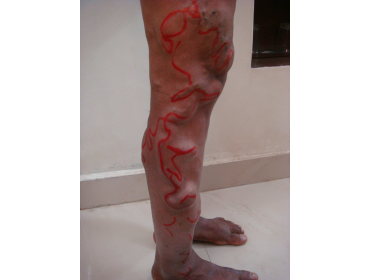
Large Vascular Malformation of leg
Successful Treatments

